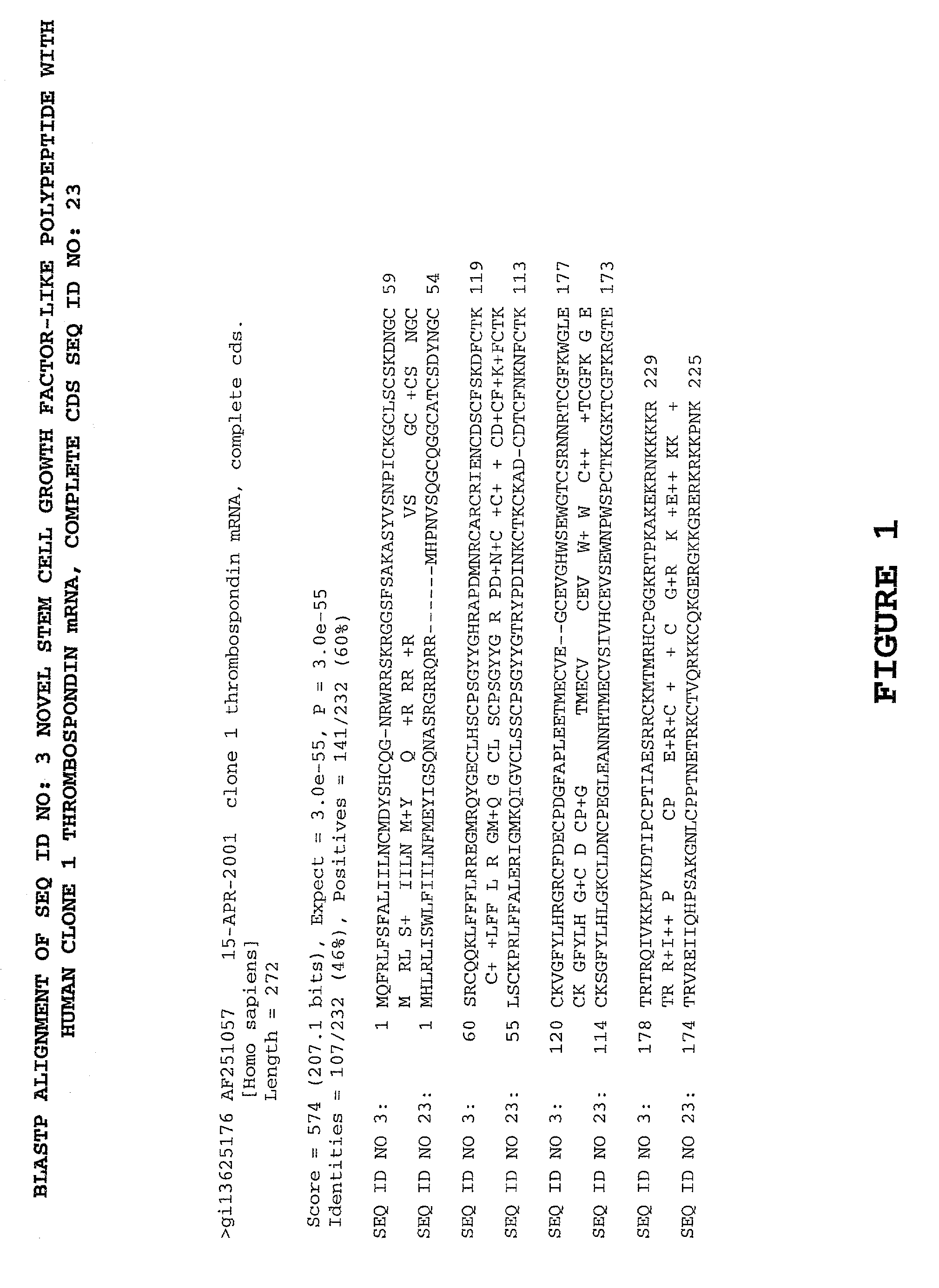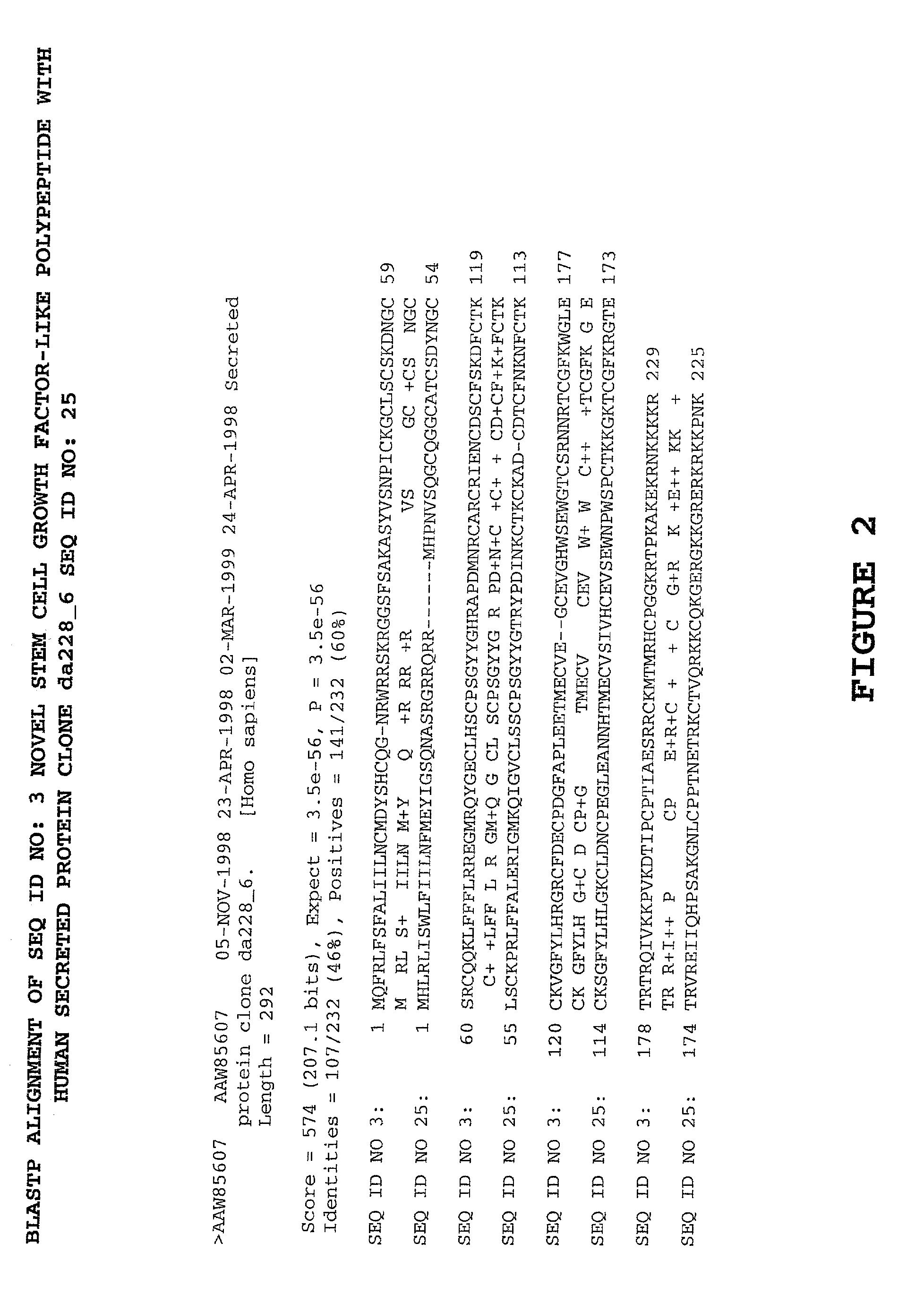Methods and materials relating to stem cell growth factor-like polypeptides and polynucleotides
a technology of stem cell growth factor and polynucleotide, which is applied in the field of polynucleotides and proteins, novel stem cell growth factorlike polypeptides, etc., can solve the problems of perinatal death, difficult culture and maintenance of stem cells in general, etc., and achieve the effect of reducing the side effects of such an agen
- Summary
- Abstract
- Description
- Claims
- Application Information
AI Technical Summary
Problems solved by technology
Method used
Image
Examples
example 1
Isolation of SEQ ID NO: 1 and 16 from a cDNA Libraries of Human Cells
[0442] The novel nucleic acid of SEQ ID NO: 1 was obtained from a human cDNA library prepared from adult brain (Clontech), using standard PCR, sequencing by hybridization sequence signature analysis, and Sanger sequencing techniques. The novel nucleic acid of SEQ ID NO: 16 was obtained from a human cDNA library prepared from fetal skin (Invitrogen), using standard PCP, sequencing by hybridization sequence signature analysis, and Sanger sequencing techniques. The inserts of the library were amplified with PCR using primers specific for vector sequences flanking the inserts. These samples were spotted onto nylon membranes and interrogated with oligonucleotide probes to give sequence signatures. The clones were clustered into groups of similar or identical sequences, and single representative clones were selected from each group for gel sequencing. The 5' sequence of the amplified inserts was then deduced using the re...
example 2
Asseblage of SEQ ID NO: 8
[0443] The novel nucleic acid (SEQ ID NO: 8) of the invention was assembled from sequences that were obtained from various cDNA libraries by methods described in Example 1 above, and in some cases obtained from one or more public databaes. The final sequence was assenmbled using the EST sequence as seed. Then a recursive algorithm was used to extend the seed into an extended assemlage, by pulling additional sequences from different databases (i.e. Hyseq's database containing EST sequences, dbEST version 119, gb pri 119, and UniGene version 119) that belong to this assemblage. The algorithm terminated when there was no additional sequences from the above databases that would extend the assemblage. Inclusion of componert sequences into the assemblage was based on a BLASTN hit to the exending assemblage with BLAST score greater than 300 and percent identity greater than 95%.
[0444] Using PHRAP (Univ. of Washington) or CAP4 (Paracel), a full-length gene cDNA sequ...
example 3
Assemblage of SEQ ID NO: 12 and 17
[0449] The novel nucleic acid (SEQ ID NO: 12 and 17) of the invention were assembled from sequences that was obtained from a cDNA library by methods described in Example 1 above, and in some cases obtained from one or more public databases. The final sequence was assembled using the EST sequences as seed. Then a recursive algorithm was used to extend the seed into an extended assemblage, by pulling additional sequences from different databases (i.e. Hyseq's database containing EST sequences, dbEST version 124, gb pri 124, and UniGene version 124) that belong to this assemblage. The algorithm terminated when there was no additional sequences from the above databases that would extend the assemblage. Inclusion of component sequences into the assemblage was based on a BLASTN hit to the extending assemblage with BLAST score greater than 300 and percent identity greater than 95%.
[0450] Using PHRAP (Univ. of Washington) or CAP4 (Paracel), a full-length ge...
PUM
| Property | Measurement | Unit |
|---|---|---|
| molecular weight | aaaaa | aaaaa |
| body weight | aaaaa | aaaaa |
| weight | aaaaa | aaaaa |
Abstract
Description
Claims
Application Information
 Login to View More
Login to View More - R&D
- Intellectual Property
- Life Sciences
- Materials
- Tech Scout
- Unparalleled Data Quality
- Higher Quality Content
- 60% Fewer Hallucinations
Browse by: Latest US Patents, China's latest patents, Technical Efficacy Thesaurus, Application Domain, Technology Topic, Popular Technical Reports.
© 2025 PatSnap. All rights reserved.Legal|Privacy policy|Modern Slavery Act Transparency Statement|Sitemap|About US| Contact US: help@patsnap.com



